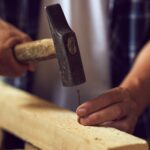Whether you’re a craft vendor looking to set up shop at your local farmers market or a maker looking to sell your handmade wares at a craft show, a well-designed booth can make all the difference. Not sure where to start? Here’s a guide to setting up your own 10×10 woodworking craft booth.
1. Choose your location
When choosing a location for your booth, consider the foot traffic and the size of the space. You want to make sure that your booth is visible and easily accessible to potential customers.
2. Decide on your display
Your display is the first thing customers will see, so you want to make sure it’s attractive and eye-catching. You can use a variety of materials to create your display, such as wood, metal, or fabric. Be sure to use a mix of high and low-priced items to create a balanced display.
3. Create a banner
A banner is a great way to introduce your booth and let customers know what you’re selling. Be sure to include your company name and logo, as well as a brief description of your products.
4. Use a table
A table is a great way to showcase your products and provide a place for customers to browse. You can also use a table to create a display area for your banner and other marketing materials.
5. Use a tent
If you’re selling your products outdoors, a tent is a must-have. Not only will it protect your products from the sun and rain, but it will also help to create a more professional look for your booth.
6. Stock up on marketing materials
To promote your booth, be sure to stock up on marketing materials, such as flyers, business cards, and posters. You can also use a banner or sign to let customers know where your booth is.
7. Be prepared for questions
Be prepared to answer questions about your products and pricing. You should also have a business card or flyer ready to hand out to customers.
8. Be friendly and polite
Be sure to smile and greet customers as they walk by your booth. This is a great opportunity to engage with potential customers and learn more about their needs.
9. Take care of your products
Be sure to keep an eye on your products, and make sure that they’re properly displayed and protected from the elements.
10. Have fun!
The most important thing is to have fun and enjoy your time at the craft show. This is a great opportunity to meet new people and promote your business.
Cass Woodworking Galion Ohio
I’m a carpenter and furniture-maker living in Galion, Ohio. I’ve been working with wood since I was a kid, and I’ve been making furniture since I was a teenager. I love working with wood, and I love making furniture. I’m a self-taught woodworker, and I’ve been making furniture for about 20 years.
I make a wide variety of furniture, including bedroom furniture, dining room furniture, living room furniture, office furniture, and even children’s furniture. I also make a lot of custom furniture, including cabinets, shelves, and even entire rooms. I also make a lot of woodworking tools and accessories, including workbenches, tool chests, and even woodworking machines.
I’m a member of the American Woodworker’s Association, and I’ve been published in the American Woodworker magazine. I’ve also been featured on the Woodworking Channel. I’m a full-time woodworker, and I’ve been making furniture for about 20 years.
Canadian Woodworking Store
is a blog about woodworking in Canada.
Woodworking is a great hobby and a useful skill. Woodworking can be used to make furniture, cabinets, toys, and other objects.
The Canadian Woodworking Store blog is a place where you can find information about woodworking in Canada. We cover topics such as woodworking tools, techniques, and projects.
We also have a forum where you can ask questions and share your woodworking experiences.
Custom Woodworking Logos
There are a few things to consider when designing a custom woodworking logo. The most important consideration is the type of woodworking you do. Is it cabinet making, carpentry, turning, or something else?
Once you have determined the focus of your woodworking business, you can start to think about the elements you want to include in your logo. A simple logo might just use the name of your business, while a more complex logo could include images of tools or woodworking projects.
If you’re not sure what type of logo would work best for your woodworking business, a professional graphic designer can help you create a logo that accurately represents your business and its unique brand.
When it comes to choosing a font for your woodworking logo, you’ll want to choose something that is easy to read and looks professional. Serif fonts are generally a good choice for logos, as they are associated with tradition and stability.
Once you’ve created a logo that accurately represents your woodworking business, you’ll need to make sure to use it consistently across all of your branding materials, from your business cards to your website. By using a consistent logo, you can help create a strong brand identity for your woodworking business.
Woodworking Vise Installation
When installing a woodworking vise, it is important to consider the type of bench you are using and the size of the vise. If you have a sturdy bench, you can install the vise with screws. If you have a weaker bench, you may need to use bolts.
The first step is to find the center of the bench. You can do this by measuring the width and the length of the bench, and dividing by two. Once you have found the center, you can mark it with a pencil.
Next, you need to find the holes in the vise. On most vises, there are two holes on the top and two holes on the bottom. The holes should be about 1-1/2″ apart.
If you are using screws, you will need to drill pilot holes in the bench. The pilot holes should be the same size as the screws. You can use a drill bit that is the same size as the screws, or you can use a bit that is a little bit smaller. This will help to prevent the screws from splitting the wood.
Once the pilot holes are drilled, you can insert the screws into the holes in the vise. You will need to use a screwdriver to do this. Then, you can use a drill to drill the pilot holes in the bench.
If you are using bolts, you will need to drill holes in the bench that are the same size as the bolts. You can do this with a drill bit that is the same size as the bolts, or you can use a bit that is a little bit smaller.
Next, you can insert the bolts into the holes in the vise. You will need a wrench to do this. Then, you can use a socket wrench to tighten the bolts.
You should also tighten the screws or bolts that hold the vise to the bench. You can do this with a screwdriver or a wrench.
Once the vise is installed, you can test it out. You should be able to open and close the vise without any problems.

Hi everyone! I’m a woodworker and blogger, and this is my woodworking blog. In my blog, I share tips and tricks for woodworkers of all skill levels, as well as project ideas that you can try yourself.





